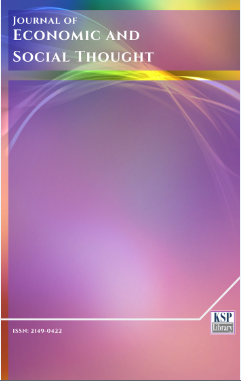Revisiting the Effects of Workers’ Remittances on Economic Development in Nigeria
Abstract
Abstract. Poverty in Nigeria continues unabated despite huge inflow of remittances. Our result supports the argument that remittances can improve economic growth but can also worsen overall wellbeing. Reasons for this are, first, remittances beneficiaries in Nigeria are concentrated in the middle income class with high propensity to consume. Second, due to high propensity to consume, consumption triggers good prices in such a way as to worsen the purchasing power of the poor. Third, institutions are weak and the poor do not benefit from weak institution. Thus good quality institutions should be encouraged while ostentatious spending should be discouraged.
Keywords. Remittances, economic development, financial institutions, governance institution.
JEL. F40, I32, C22.
References
Antwi, S., Mills, E., & Zhao, X. (2013). Remittances and the poverty nexus: Evidence from Ghana. International Journal of Academic Research in Economics and Management Sciences, 2(1), 206-223.
Barajas, A., Fullenkamp, M., Gapen, M., & Montiel, P (2009). Do workers’ remittances promote economic growth? IMF Working Paper WP/09/153.
Barro, R (1996). Determinants of economic growth: A cross-country study. NBER Working Paper 5698. National Bureau of Economic Research. doi. 10.3386/w5698
Capistrano, I., & Sta, I. (2007). The impact of international labour migration and remittances on poverty in the Philippines. UP School of Economics Discussion Papers.
Catrinescu, N., Leon-Ladesma., Piracha, M., &Quillin, B. (2008). Remittances, institutions and economic growth. IZA Discussion Paper, No. 2139. doi. 10.10.1016/j.worlddev.2008.02.004
Central Bank of Nigeria (2013). Statistical Bulletin. Central Bank of Nigeria, Abuja.
Chami R., Fullenkamp, C., & Jahjah, S (2003). Are immigrant remittances a source of capital for development? IMF Working Paper 03/189. doi. 10.2139/ssm.463002
Cox, E., & Ureta, M. (2003). International migration, remittances and schooling: Evidence from El Salvador. Journal of Development Economics, 72, 429-461. doi. 10.3386/w9766
Dollar, D., & Kraay, A. (2004). Trade, growth, and poverty. Economic Journal, 114(493), 22-49. doi. 10:1111/j.0013-0133.2004.00186.x
Goschin, Z., (2014). Remittances as an eceonomic development factor: empirical evidence from the CEE countries. Procedia Economics and Finance, 10, 54-60. doi. 10.1016/S2212-5671(14)00277-9
Giuliano, P., & Ruiz-Arranz, M. (2009). Remittances, financial development and growth. Journal of Development Economics, 90(1), 144-152. doi. 1016/j.jdeveco.2008.10.005
International Monetary Fund (2013). Balance of Payments Yearbook. The World Bank. Washington DC. doi. 10.5089/9781484315439.004
Kiio, J., Soi, N., & Buigut, K. (2014). The impacts of workers’ remittances on economic growth: evidence from Kenya. Journal of Economic and Sustainable Development, 5(26), 83-96.
Lopez-Cordova, E., (2005). Globalization, migration and development: The role of Mexican migrant remittances. Inter-American Development Bank Working Paper, 20.
McLeod, D., & Molina, J. (2005). Remittances, Inequality and Poverty Reduction: Some Tests for Latin America. Papers prepared for the LACEA meetings, AUP Paris, France.
Millennium Development Goal (2005). The Millennium Development Goal Report. United Nations, New York. doi. 10.1371/journal.pmed.0020379.
NBS (2013). Annual Yearbook of Statistics. National Bureau of Statistics, Abuja.
Nyeachi, J., & Atiga, O. (2014). Remittances and economic growth: Empirical evidence from Ghana. European Journal of Business and Management, 6(25),142-149.
Olubiyi, E (2013). Workers’ Remittances, Governance Institutions and Investment in Nigeria. Journal of Banking and Finance, 5(1), 63-81.
PRS (2013). International Country Risk Guide. Political Risk Service, New York.
Ramirez, M., & Sharma, A. (2009). Remittances and growth in Latin America: A panel unit root and panel cointegration analysis. Economic Studies of International Development, 9(1):5-36.
Ravallion, M., (1997). Can high-inequality developing countries escape absolute poverty? Economic Letters, 56, 51-57. doi. 10.1016/SO165-1765(97)00117-1.
World Bank (2006). Global Economic Prospects: Economic Implication of Remittances. The World Bank, Washington DC. doi. 10.1596/978-0-8213-6344-7
World Bank (2014). World Development Indicators. The World Bank, Washington DC. doi. 10.5257/wb/wdi/2014-04
Yang, D (2003). Remittances and human capital investment: Child schooling and child labour in the households of overseas Filipino Workers. Unpublished Manuscript, Gerald R. Ford School of Public Policy and Department of Economics, University of Michigan, Ann Arbor. doi. 10.1257/0895330053147895-4.21
DOI: http://dx.doi.org/10.1453/jest.v2i4.549
Refbacks
- There are currently no refbacks.
Journal of Economic and Social Thought - J. Econ. Soc. Thoug. - JEST - www.kspjournals.org
ISSN: 2149-0422
Editor: [email protected] Secretarial: [email protected] Istanbul - Turkey.
Copyright © KSP Library




